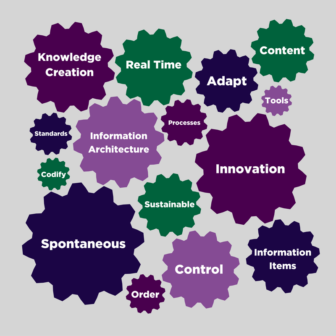 How can spontaneous innovation and organizational standards live happily in the same knowledge management system?
How can spontaneous innovation and organizational standards live happily in the same knowledge management system?
While working with a client recently, I was impressed by how much innovation I was seeing throughout the organization. Folks were “figuring things out” in real time, answering questions, building tools and capturing processes to help them do their jobs better. That is of course just the kind of thing that social organizations try to inspire: Actual organic knowledge creation that can be reused again and again.
This type of spontaneous knowledge creation can come at a cost, however.
If organizations are left to simply create information items on the fly and add to them day after day, they are soon left with a mess. As the number of knowledge items increase and repositories for knowledge and information propagate, information that was at one time truly useful becomes impossible to find. When knowledge workers can’t find the information they are looking for, they create a new version. Where there once was a single knowledge item, now there are three or four or five….all different and none of them authoritative or trustworthy.
That is of course where standards for information architecture, taxonomy, and types of content come in. EK is often called upon to help organizations develop enterprise-wide standards that bring order out of chaos; we help organizations create standards and practices that allow them to find and maintain their information in a manageable and sustainable way.
Centralized standards, however, often feel heavy and bureaucratic to the innovators in an organization. They are often viewed as just another example of top-down control that doesn’t allow them to figure things out or create a solution.
How can we apply centralized standards and practices without discouraging spontaneous knowledge creation? Or better yet, how can information standards be used to inspire rather than discourage innovation in the enterprise?
What if we used the information items that are being created organically as the basis for the enterprise-wide information standards? Giving knowledge workers a stake in creating standards for knowledge management is a natural way to codify the best thinking of an organization.
Consider using these methods for developing standards more organically in your organization:
- Choose the best examples of content (e.g. job aids, information capture, processes) and adapt those into a standard by creating a specific structure and template. By refining and codifying information items and tools that already exist, the new standards will look entirely familiar to your staff.
- Use or adapt the popular name of the information item into the standard. If knowledge workers call it a “job aid” and it can be adapted into a standard, then call the new standard a “job aid.”
- Encourage knowledge workers to suggest new standards as they innovate. Instead of simply improvising a new tool or documenting a process, get them to think in terms of creating a new type of information for the organization. There needs to be a check in place to be sure that the newly suggested standard is truly unique and doesn’t already exist under a different name but that is just part of the process.
Channeling the innovative energy in an organization toward standards creation often requires a cultural shift. Think of it as moving from simply improvising (to solve an immediate problem) to truly innovating (creating a solution that can be used again and again). EK can help you with the design, implementation, and change management necessary to be successful.
